Homicide in Scotland 2018-2019: statistics
Statistical bulletin on crimes of homicide recorded by the police in Scotland in 2018-2019.
This document is part of a collection
Commentary
Homicide cases
Table 1; Charts 1, 2
- The number of homicide cases recorded by the police in Scotland increased by 2% (or one case) between 2017-18 and 2018-19 from 59 to 60. This is the third lowest annual number of homicide cases since 1976, the first year for which comparable data are available. The two years with a lower figure were 2015-16 and 2017-18, both of which had 59 cases recorded.
- Following a generally downward trend between 2004-05 and 2012-13 the number of homicide cases in Scotland has remained relatively stable with between 59 and 63 recorded each year during 2012-13 to 2018-19 (Chart 1).
Chart 1: Cases recorded as homicide by the police, Scotland, 1999-00 to 2018-19
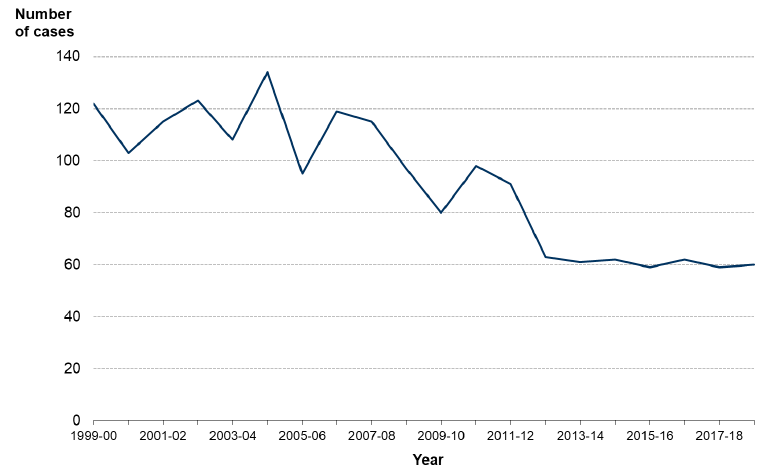
- Homicide cases involving more than one victim are relatively rare, in 2018-19 there was one case with more than one victim (Table 1). Of the 60 homicide cases recorded, 18 involved more than one accused person.
Table 1: Summary table of homicide cases, victims and accused persons, Scotland, 2009-10 to 2018-19
| 2009-10 | 2010-11 | 2011-12 | 2012-13 | 2013-14 | 2014-15 | 2015-16 | 2016-17 | 2017-18 | 2018-19 | |
|---|---|---|---|---|---|---|---|---|---|---|
| Total number of cases | 80 | 98 | 91 | 63 | 61 | 62 | 59 | 62 | 59 | 60 |
| Cases by number of victims: | ||||||||||
| 1 | 78 | 97 | 90 | 63 | 60 | 62 | 59 | 59 | 59 | 59 |
| 2+ | 2 | 1 | 1 | - | 1 | - | - | 3 | - | 1 |
| Total number of victims | 82 | 100 | 93 | 63 | 62 | 62 | 59 | 65 | 59 | 61 |
| Median age of victims | 41 | 33 | 35 | 38 | 42 | 42 | 37 | 40 | 39 | 42 |
| Cases by number of accused: | ||||||||||
| 1 | 53 | 68 | 66 | 45 | 47 | 49 | 48 | 48 | 45 | 39 |
| 2 | 20 | 19 | 13 | 11 | 8 | 9 | 9 | 5 | 8 | 10 |
| 3+ | 6 | 10 | 10 | 6 | 6 | 4 | 1 | 6 | 5 | 8 |
| unsolved | 1 | 1 | 2 | 1 | - | - | 1 | 3 | 1 | 3 |
| Total number of accused | 121 | 142 | 127 | 85 | 90 | 80 | 69 | 78 | 81 | 83 |
| Median age of accused | 27 | 28 | 29 | 30 | 30 | 31 | 29 | 30 | 35 | 30 |
- In 2018-19, Glasgow City had the highest number of homicide cases (13), representing 22% of the Scottish total (Table 2). Glasgow City has nearly double its share of homicides compared to its population (with 12% of the Scottish population in 2018[1]). It is important to note however that victims may not necessarily reside in the local authority where the homicide took place. Glasgow City has also witnessed a relatively larger fall in homicides of 35% since 2009-10, accounting for over one third (35%) of the overall national decrease.
Chart 2: Location of homicide cases, where known, Scotland, 2009-10 to 2018-19
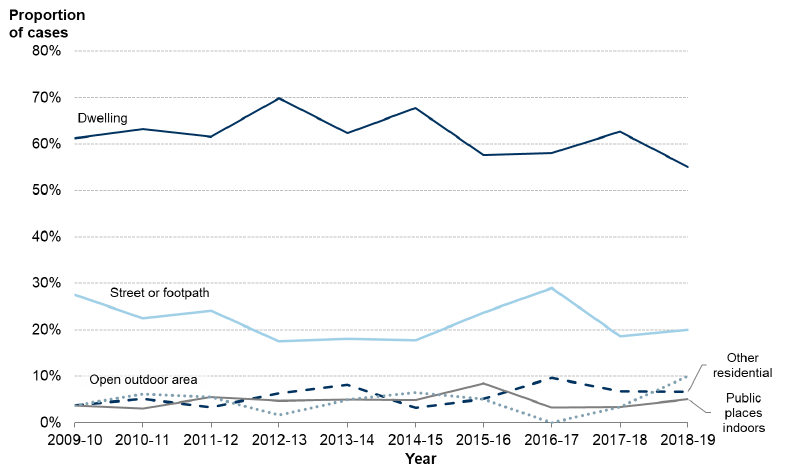
- In 2018-19, 62% of homicides occurred within a residential location (dwelling and other residential), 30% in outdoor public places (street, footpath and open outdoor area) and 5% in indoor public places (Chart 2).
Victims of homicide
Table 5; Charts 3, 4
- Between 2017-18 and 2018-19, the number of homicide victims in Scotland increased by 3% (or two victims), from 59 to 61 (Chart 3).
Chart 3: Total number of victims and victims by gender, Scotland, 1999-00 to 2018-19
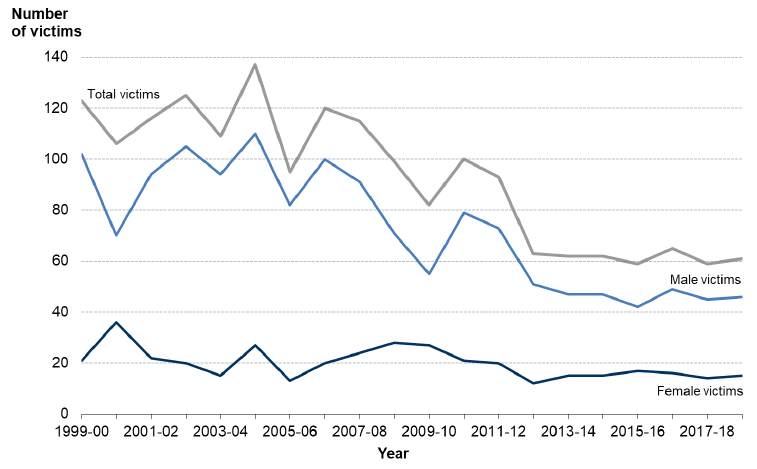
- In 2018-19, there were 46 male victims, representing 75% of all homicide victims. Males are more likely to be victims compared to females, with an overall rate for males of 17 victims per million population, more than three times the rate for females (five victims per million population).
- Chart 4 shows the victimisation rate by age group and gender for homicides since 2009-10 (i.e. for the past 10 years – representing 706 victims). For most age groups, the victimisation rate is higher for males than for females, though rates were almost identical for those aged between one and 15 years old. The victimisation rate for males peaks in the 21 to 30 years old age group.
- The median age of a victim of homicide in 2018-19 was 42 years old, three years higher than in 2017-18 when the median age of a victim was 39 years old. Over the past ten years the median age of a victim has ranged between 33 and 42 years old (Table 1).
Chart 4: Age profile of homicide victimisation rate by gender, Scotland, 2009-10 to 2018-19
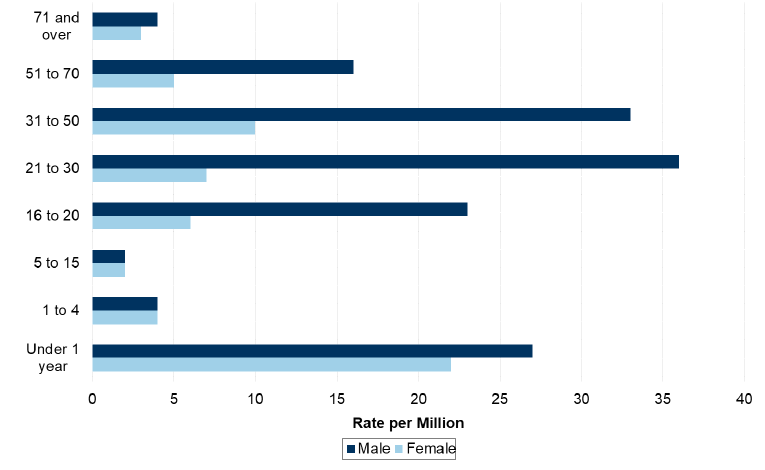
Persons accused of homicide
Table 6; Charts 5, 6
- The number of people accused of homicide has shown an overall downward trend since 2004-05 (Chart 5). In 2018-19 there were 83 persons accused of homicide, two more than in 2017-18 though remaining lower than all years between 1991-92 and 2013-14.
- The vast majority of persons accused of homicide since 1999-00 have been male, making up 88% of all accused in 2018-19.
- Of the 60 cases of homicide recorded for 2018-19, 57 were solved and three are currently unsolved.
Chart 5: Total number of accused and accused by gender, Scotland, 1999-00 to 2018-19
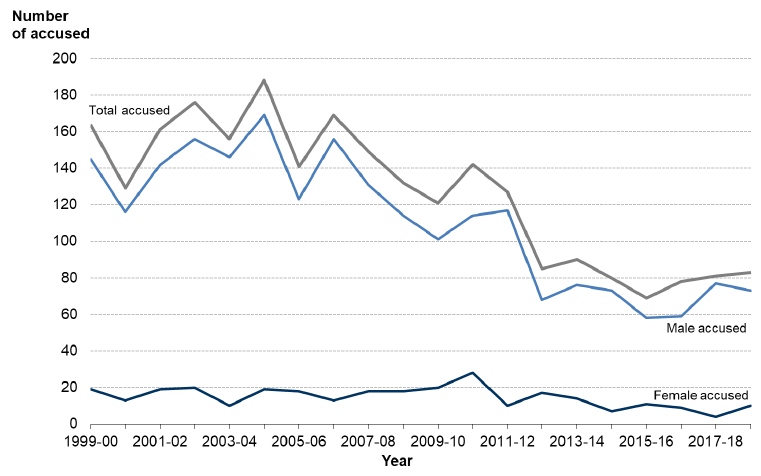
- In 2018-19, the total number of individuals accused of homicide equated to 15 per million population.
- In 2018-19, the rates for those accused of homicide were highest for the 21 to 30 years old age group, at 39 per million population.
- Chart 6 shows the rate for accused by age group and gender for homicides since 2009-10 (i.e. for the past 10 years – representing 956 accused). The rates for males accused of homicide per million population were considerably higher across all age groups than for females.
- In 2018-19, the median age of a person accused of homicide was 30 years old, which is five years younger than in 2017-18 when the median age was 35 years old. Over the past ten years the median age of a person accused of homicide ranged between 27 and 35 years old (Table 1).
Chart 6: Age and gender profile of persons accused of homicide per million population, Scotland, 2009-10 to 2018-19
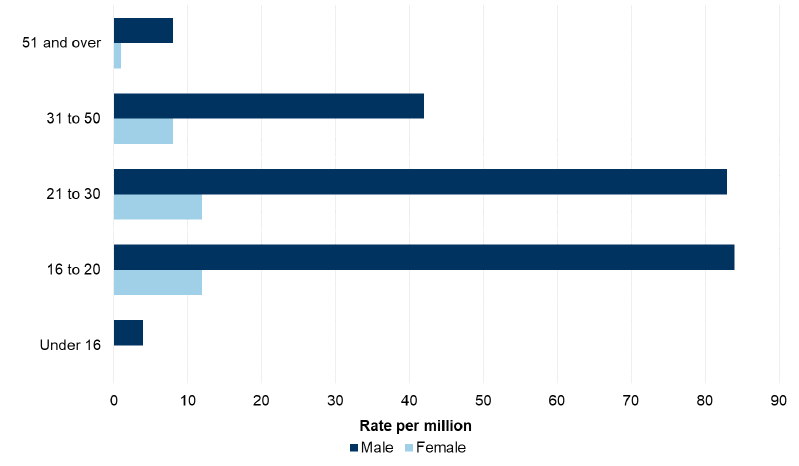
Method
Table 7; Chart 7
- Chart 7 shows that the most common main method of killing in each of the last ten years was with a sharp instrument. This includes 44% (27) of homicide victims in 2018-19, of which all but two involved a knife. For the other two the type of sharp instrument was unknown. The next most common main method was with a blunt instrument, accounting for 23% (14) of homicide victims in 2018-19.
- Homicide by shooting is relatively rare in Scotland. In 2018-19 there were three victims recorded and since 2009-10 there has only been one other year where more than two victims were recorded (2011-12).
Chart 7: Victims of homicide by main method of killing, 2009-10 to 2018-19
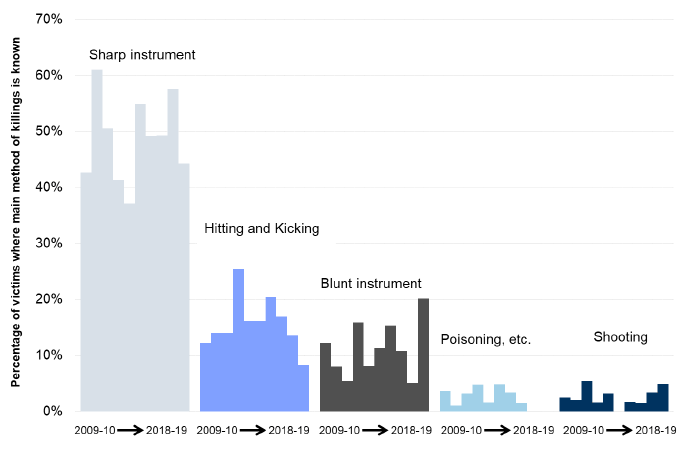
Relationship of main accused to victim
Tables 8-10; Charts 8-9
- The victim and main accused were known to each other in a majority of cases, representing 81% of homicide cases solved in 2018-19. The accused was unknown to the victim in nine cases (16%). This latter group includes six cases where the victim was not known to the accused and three cases where the victim was known to the accused. Of those cases where the victim and accused were known to each other, 68% were acquaintances, 21% were partners or ex-partners and 11% were relatives. The relationship to the main accused was unknown in the remaining 3% of cases.
- Chart 8 shows the percentage of homicides for male and female victims by their relationship to the main accused for all victims since 2009-10. Over the past ten years, a majority of male victims were killed by an acquaintance (59%). Over the same period, 44% of female victims were killed by a partner or ex-partner.
- Table 9 shows that between 2009-10 and 2018-19, a total of 34 children under the age of 16 years were victims of homicide (where there was an accused person). Of these, 79% were killed by one of their parents. Since 2009-10 there have been 13 victims aged under one year old and in all but two cases (where there was an accused person) the main accused was a parent.
Chart 8: Relationship between victim and main accused, by victim gender, Scotland, 2009-10 to 2018-19
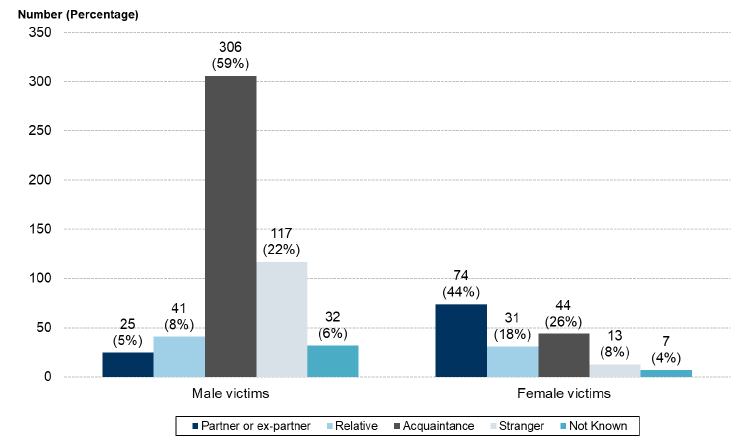
- Table 9 also shows that for all homicides recorded in the last ten years, 61% of male victims aged between 16 and 70 years old were killed by an acquaintance, 23% were killed by a stranger, 5% were killed by a partner or ex-partner and 3% were killed by a relative. Just over half (52%) of female victims aged between 16 and 70 years old were killed by their partner or ex-partner, 27% were killed by an acquaintance, 8% were killed by a son or daughter and 7% were killed by a stranger.
- Chart 9 shows that two-thirds of all homicide cases (67%) recorded between 2009-10 and 2018-19 involved males killing males. Cases where the main accused and main victim were both female accounted for just 4% of the total number.
Chart 9: Relationship between main accused and victim by gender, Scotland, 2009-10 to 2018-19
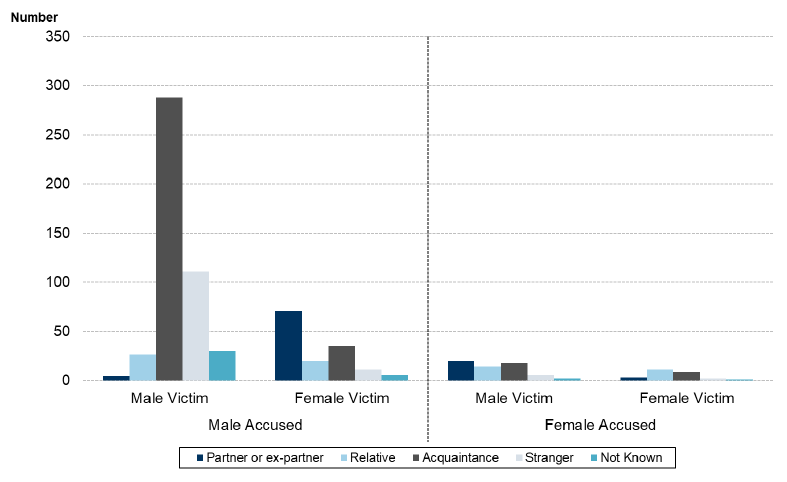
Main motive
Tables 11 - 14
- The most common reasons recorded for committing homicide in the ten year period between 2009-10 and 2018-19, were fight or quarrel, and rage or fury, with half (48%) of all victims in solved cases killed in such circumstances. For a further 23% of victims during this ten year period the motive was unknown (Table 11).
- In terms of the most recent year (2018-19), fight or quarrel and rage or fury accounted for 19% of all victims in solved cases. A further 48% of cases had an unknown motive. A relatively higher proportion of victims were killed in cases where the motive was a feud or faction rivalry (19%) than over the last ten years as a whole (9%).
- In the period 2009-10 to 2018-19, 83% of all female victims were killed in a dwelling, compared with 55% of males. Table 12 also shows the location, relationship and motives associated with all homicides recorded over the past ten years. The most common set of circumstances associated with a male victim are a rage or fight with an acquaintance in a dwelling (accounting for 19% of male victims). The second most common set of circumstances are a rage or fight with an acquaintance not in a dwelling, accounting for a further 13% of male victims.
- The most common set of circumstances associated with a female victim are a rage or fight with a partner or ex-partner in a dwelling (accounting for 18% of female victims). The second most common set of circumstances are an unknown motive with partner or ex-partner in a dwelling, accounting for a further 12% of female victims.
- Thirty-three (57%) victims were reported to have been killed in drug-related homicide cases in 2018-19, of which 26 were male (Table 13). The number of drug-related homicide cases has increased over the past two years, though Police Scotland advise that this may be due at least in part to an improvement in recording practice (i.e. better identification of where motives can include a drug-related element). Given this, users are advised to exercise some caution when comparing this variable with earlier years, particularly those prior to 2016-17.
- None of the homicides recorded in 2018-19 were reported to have had a racial motivation. One case had a homophobic motivation. In all homicide cases in the ten years leading up to 2018-19, 2% had a homophobic or racist motivation (Table 14).
Use of alcohol and drugs
Tables 15-18; Chart 10
- Of the 83 persons accused in homicide cases in 2018-19, 29 (35%) were reported to have been under the influence of alcohol, drugs or a combination of both at the time of the homicide. These 29 accused break down into 14 (17% of all accused) who were under the influence of both alcohol and drugs, 11 (13%) who were under the influence of alcohol alone and four (5%) who were under the influence of drugs alone (Table 15).
- In 2018-19, the alcohol and drug status of the accused was unknown for 53 persons, 64% of all accused. One accused person (1%) was reported to have been neither under the influence of alcohol nor drugs at the time of the homicide (Table 15).
- In the ten year period between 2009-10 and 2018-19, around half (46%) of all accused were reported to have been under the influence of alcohol and/or drugs at the time of the homicide. This is slightly higher for males (47%) than females (40%) (Table 16).
- Chart 10 shows that over the last ten years, 23% (93) of homicides, where the accused was suspected of being under the influence of alcohol, occurred on a Saturday. Furthermore, around three fifths of homicides where the accused was under the influence of alcohol (60% or 241) occurred during the weekend (i.e. Friday, Saturday and Sunday).
Chart 10: Distribution of the accused of homicide under the influence of alcohol[2] by day of the week 2009-10 to 2018-19
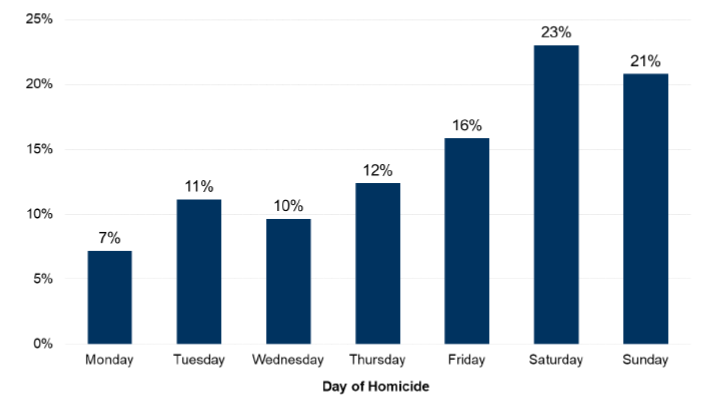
Comparator statistics
Table 4; Chart 11
- This bulletin has reported a decreasing trend in homicides over the longer term. Chart 11 shows this trend and compares it to the trend in attempted murder and serious assaults. This latter information is taken from the Recorded Crime in Scotland, 2018-19 bulletin. Over the ten year period between 2009-10 and 2018-19, the reduction in levels of homicide has broadly followed a similar fall in levels of attempted murder and serious assault. The number of homicide cases has fallen by 25% over the last ten years, compared with a 45% fall in attempted murder and a 20% fall in serious assault.
Chart 11: Indices in selected crimes of violence, Scotland, 2009-10 to 2018-19 (Index 2009-10 = 100)
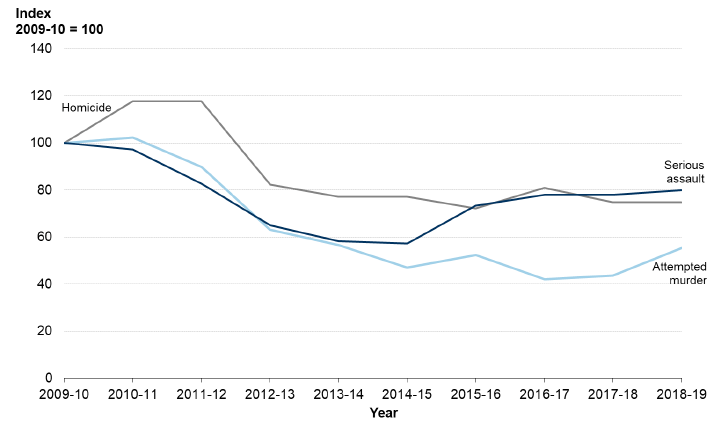
- Similar to Scotland, England & Wales also produce National Statistics on Homicide, which is extracted from a dedicated database - the Home Office Homicide Index. The latest data published was for the 2017-18 reporting year[3].
- Direct comparisons between Scotland and England & Wales should be treated with some caution due to uncertainty around different counting and classification conventions.
- Further to this, users should note that in England & Wales, as in Scotland, it is possible for homicides that occurred sometime in the past to be recorded in more recent years. For example whilst the data for 2018-19 are not yet available, the Office for National Statistics (ONS) has previously highlighted that earlier figures for 2016-17 included the 96 victims of Hillsborough which occurred in 1989, representing 14% of all victims in 2016-17.
- One area where some general comparisons can be made are the broad trends in changes over time between Scotland and England & Wales, though still allowing for the caveats outlined above.
- In Scotland, the number of homicide cases has fallen over the longer term but have remained relatively stable in recent years, with between 59 and 63 cases recorded each year since 2012-13. The 2018-19 figures for England & Wales will be published in 2020. The latest publication for 2017-18 reported that homicide in England & Wales has also fallen over the longer term but has shown increases since 2014-15.
Contact
Email: JusticeAnalysts@gov.scot
There is a problem
Thanks for your feedback